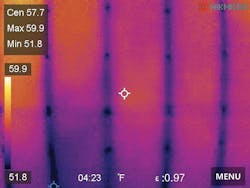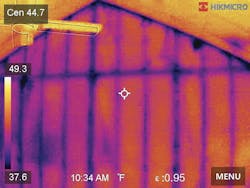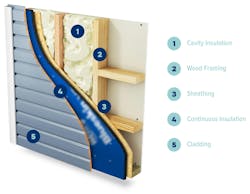Thermal bridges are places in the building envelope where heat can pass through more easily. They occur where more conductive materials form a “bridge” between the interior and exterior of the envelope, bypassing insulation.
Wall studs are the perfect example. Residential construction in the U.S. has typically been built with 2x4 wood studs spaced 16 or 24 inches on center with fiberglass cavity insulation in between. The insulation is great for thermal resistance, but the studs form thermal bridges that create other problems for the home.
First, the wood studs make up roughly 25% of the wall structure, leaving the equivalent of one whole wall without insulation. The thermal bridging that occurs through the studs significantly detracts from the overall thermal resistance of the insulation, reducing comfort and energy efficiency.
More critically, thermal bridging also increases opportunities for interstitial condensation. This occurs when the temperature of the studs significantly differs from the surrounding insulating materials, causing condensation that promotes mold growth, rot, and structural damage.
According to Randy Williams, energy auditor and president of construction company Willcon, rot and structural damage can develop slowly, making it difficult to detect. What happens in a shorter time frame is mold growth. Homeowners may notice mold behind furniture or an issue called ‘ghosting’ where dust and dirt collect on damp areas of the wall, Williams says.
“Often these issues are caused by condensation accumulating at the thermal bridge along the wall framing, but they can be erroneously attributed to an exterior water leak,” he explains. “That’s why it’s important for remodelers to understand thermal bridging and where it occurs, so they can work with homeowners to provide appropriate remediation.”
Re-siding jobs are an great time for remodelers to correct thermal bridging and add value for homeowners by including continuous insulation as part of the re-siding project, Williams adds. Knowledge of thermal bridging is also important for remodelers building home additions, so they don’t unintentionally create these same undesirable conditions.
Thermal Bridging Prevention
For a remodeling project to prevent thermal bridging, contractors must recognize how and where it occurs. The most common type is the repeating thermal bridge that appears at regular intervals, such as the wood studs in framing that use a 16-inch or 24-inch pattern. Thermal imaging of a home constructed using cavity insulation alone indicates cooler blue colors at the studs in contrast to the warmer red/orange insulated areas in between.
In an existing home, thermal imaging is the easiest way to spot these thermal bridges, but remodelers may notice other signs, too, or learn about them from the homeowner. These can include increased home energy consumption, reduced homeowner comfort, and interior mold growth or ghosting.
By identifying these signs, remodelers can target areas for improvement.
Continuous insulation Solves Thermal Bridging Problems
Since the early 2000s, continuous insulation (CI) has become increasingly popular in home construction, driven by the need for better energy efficiency and compliance with increasingly stringent building codes. While this is good news when it comes to eliminating thermal bridging and its associated problems, it still means that the majority of American homes are without the protections that CI provides. Recognizing this is important for remodelers, as older homes are often where renovations and additions are in demand.
A recent innovation that is poised to improve the way building envelopes are constructed and how they perform is the integrated panel. These products combine CI with a weather-resistive barrier to eliminate thermal bridging for better energy efficiency and moisture control. These panels can save remodeling contractors one full step during a re-siding or new addition, providing a significant reduction in installation labor. One of the newest innovations in this category also includes a pre-applied seam sealing solution that delivers a more dependable, uniform seal and further adds to installation efficiency. All these features make the integrated panel particularly appealing to contractors with small or less experienced crews, as installation is streamlined while panel performance is improved.
Innovating for a Competitive Edge
Addressing thermal bridging with new integrated panel innovations is a great way for remodeling contractors to build a competitive edge. First, it enables them to add value for homeowners and create a reputation as a problem-solving partner in home comfort and efficiency. It’s also an opportunity to gain measurable worksite efficiencies like faster, cleaner installation and stay ahead of the game in meeting building codes for energy efficiency.




